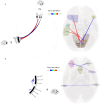Functional Connectivity Changes Associated With Depression in Dementia With Lewy Bodies
- PMID: 40011213
- PMCID: PMC11865007
- DOI: 10.1002/gps.70058
Functional Connectivity Changes Associated With Depression in Dementia With Lewy Bodies
Abstract
Objectives: Depressive symptoms are frequent in the early stages of dementia with Lewy bodies (DLB), and more than half of DLB patients would have a history of depression. Our study sought to investigate the functional connectivity (FC) changes associated with depressive symptoms in prodromal to mild DLB patients compared with controls.
Methods: MRI data were collected from 66 DLB patients and 18 controls. Depression was evaluated with the Mini International Neuropsychiatric Interview. Resting-state FC (rsFC) was investigated with the CONN toolbox using a seed-based approach and both regression and comparison analyses.
Results: Correlations were found between the depression scores and the rsFC between fronto-temporal and primary visual areas in DLB patients (p < 0.05, FDR corrected). Depressed DLB patients also showed decreased rsFC within the salience network (SN), increased rsFC between the default mode network (DMN) and the language network (LN) and decreased rsFC between the cerebellar network (CN) and the fronto-parietal network (FPN) compared to non-depressed DLB patients (p < 0.05, uncorrected). Comparison analyses between antidepressant-treated and non-treated DLB patients highlighted FC changes in treated patients involving the SN, the DMN, the FPN and the dorsal attentional network (p < 0.05, uncorrected).
Conclusions: Our findings revealed that depressive symptoms would especially be associated with rsFC changes between fronto-temporal and primary visual areas in DLB patients. Such alterations could contribute to difficulties in regulating emotions, processing biases towards negative stimuli, and self-focused ruminations.
Trial registration: This study is part of the cohort study AlphaLewyMA (https://clinicaltrials.gov/ct2/show/NCT01876459).
Keywords: antidepressant treatment; dementia with Lewy bodies; depression; fMRI; salience network.
© 2025 The Author(s). International Journal of Geriatric Psychiatry published by John Wiley & Sons Ltd.
Conflict of interest statement
The authors declare no conflicts of interest.
Figures




